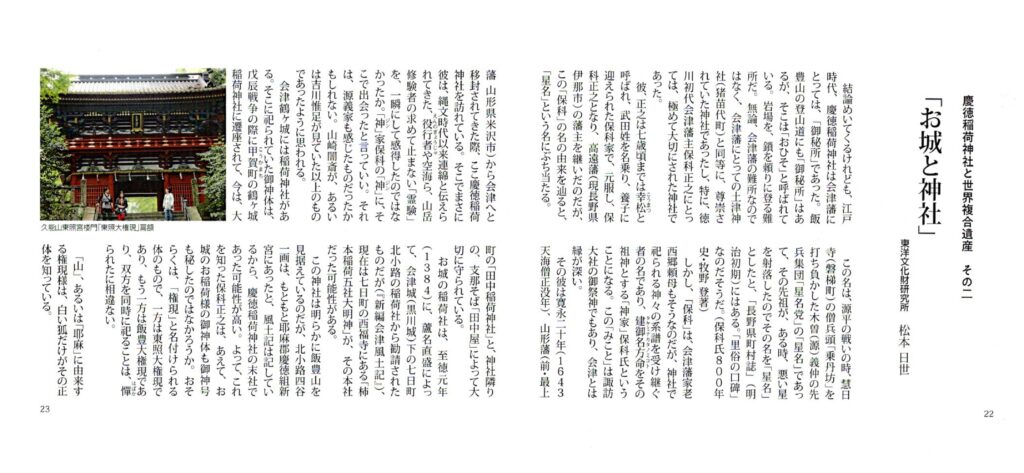Castles and Shrines

Keitoku Inari Shrine and World Heritage Site 2
This brings me to the conclusion, but in the Edo period, Keitoku Inari Shrine was a “secret place” for the Aizu clan. There is also a “secret place” on the mountain trail of Mt. Iide, but it is called “Ohisso.” It is a difficult spot where you climb up a rocky area using chains. Of course, it is not a difficult place for the Aizu clan, but it was a shrine that was revered on the same level as Tsuchi Shrine (Inawashiro Town) for the Aizu clan, and it was especially important to Hoshina Masayuki, the first Tokugawa lord of the Aizu clan.
Masayuki was called Komatsu until he was about seven years old, took the surname Takeda, and was adopted into the Hoshina family. After coming of age, he became Hoshina Masayuki and succeeded as lord of Takato Domain (present-day Ina City, Nagano Prefecture). If you trace the origin of the name “Hoshina,” you will come across the name “Hoshina.”
This name is the “Hoshiname” of the “Hoshiname Party,” a group of vanguard soldiers of Kiso (Minamoto) Yoshinaka who defeated the head monk of Enichi-ji Temple (Bandai Town) during the Genpei War, and the Nagano Prefecture Town and Village Chronicle (early Meiji period) states that the name was chosen because an ancestor of the group shot down an evil star. It is said to be “oral tradition among the local people.” (800-Year History of the Hoshina Clan, by Makino Noboru)
However, “Hoshina” is the name of someone who inherits the lineage of the gods worshiped at shrines, as is the case with Aizu clan elder Saigo Tanomo, and the Hoshina clan is a “divine family” whose ancestor is Takeminakata no Mikoto. This “Mikoto” is also the deity worshiped at Suwa Taisha Shrine, and has a deep connection with Aizu.
When he was transferred from Yamagata Domain (formerly Mogami Domain, Yonezawa City, Yamagata Prefecture) to Aizu in 1643 (the year of the death of Sojo Tenkai), he visited Keitoku Inari Shrine here. There, he instantly felt the miraculous powers that have been passed down since the Jomon period and that mountain ascetics such as En no Gyoja and Kukai have been seeking endlessly. It can be said that he met the god of Kahoshina there. It may have been something that Minamoto no Yoshiie also felt. It seems to have been more than what Yamazaki Ansai or Yoshikawa Koretari had seen.
There is an Inari Shrine at Aizu Tsuruga Castle. The deity that was enshrined there was moved to Tsuruga Castle Inari Shrine in Koka Town during the Boshin War, and is now carefully protected by Tanaka Inari Shrine in Omachi and the Chinese noodle shop Tanakaya next to the shrine.
The castle’s Inari shrine was enshrined in 1384 by Ashina Naomori from the Inari shrine in Kitakoji, Nanukamachi, under Aizu Castle (Kurokawa Castle) (“Shinpen Aizu Fudoki”).
It is possible that the main shrine was the “Kakimoto Inari Gosha Daimyojin” currently located at Saifukuji in Nanukamachi.
This shrine clearly overlooks Mt. Iide, but the Fudoki records that the area around Yotsuya, Kitakoji, was originally located in Shingu, Keitokumi, Yama County, so it is highly likely that it was a sub-shrine of Keitoku Inari Shrine. Therefore, when Hoshina Masayuki learned of this, he may have deliberately kept the object of worship and the divine title of the castle’s Inari shrine secret. It is likely that they are both “gongen” in form, with one being Tosho Daigongen and the other being Iide Daigongen, and it would have been hesitant to enshrine both at the same time.
The true identity of this Gongen deity, whose name derives from the kanji for “mountain” or “yama,” is known only to the white fox.
